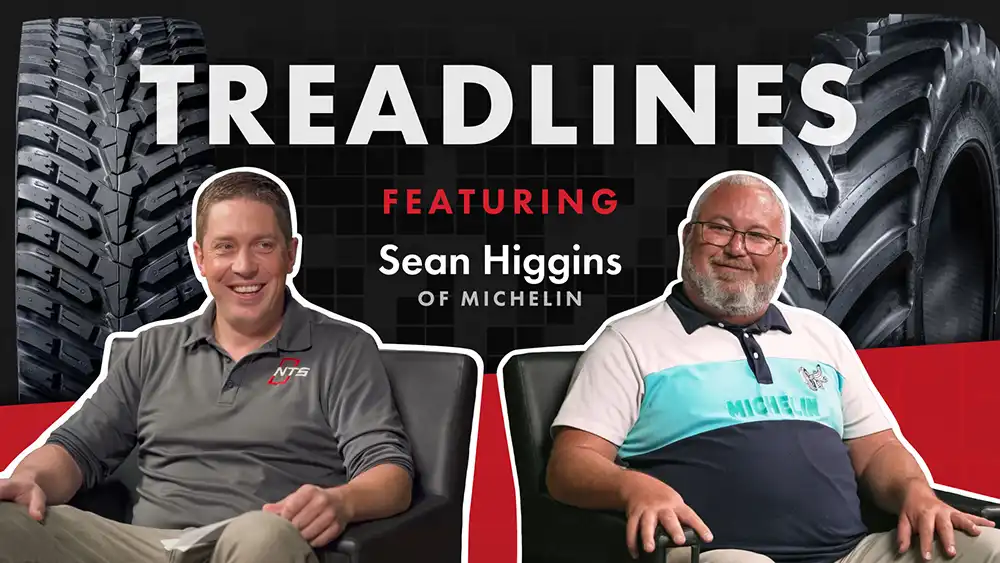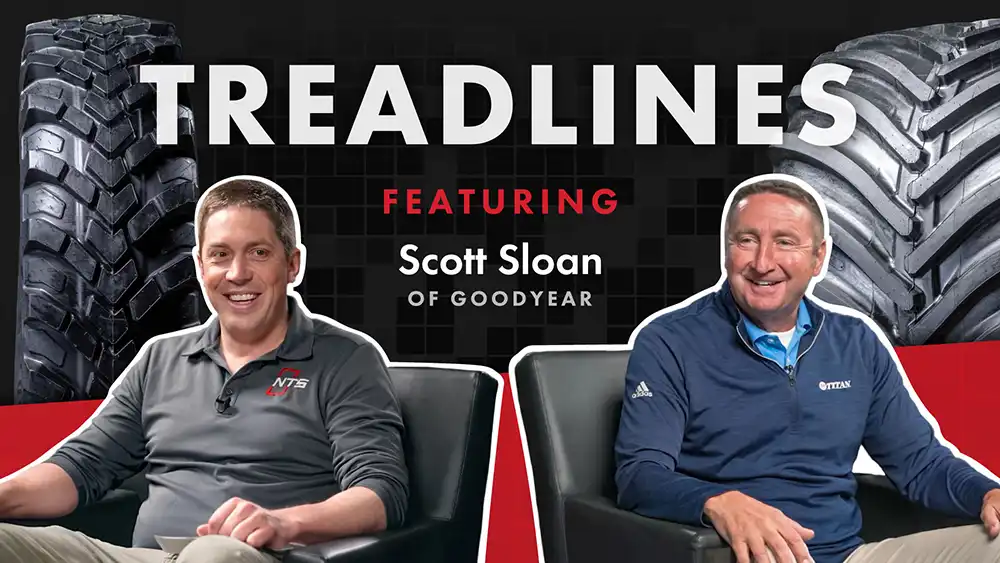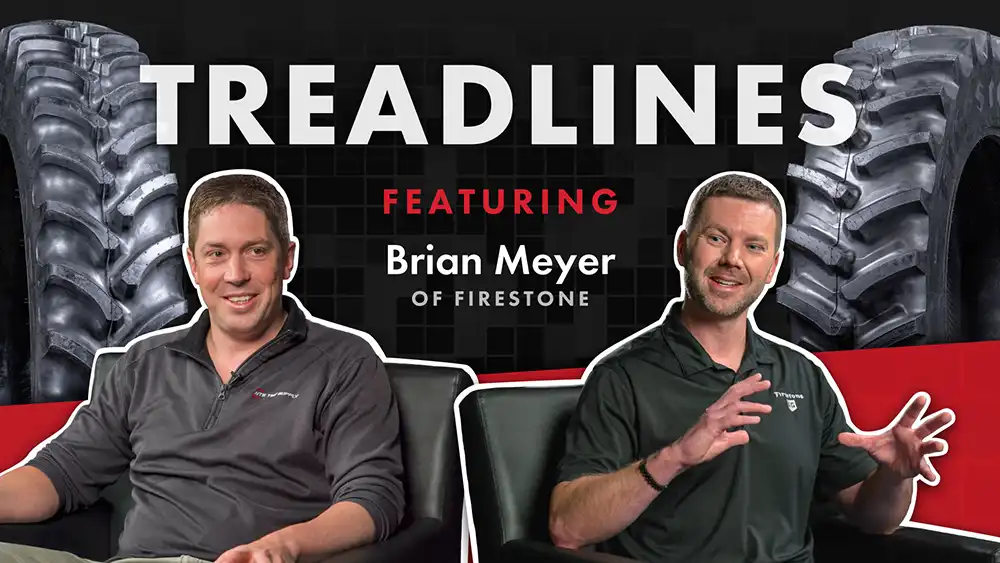It pays to set your tire pressures as low as possible in the field. As one farmer we’ve talked to said, “If you want more bushels, just give it a try. You won’t be disappointed.” We’ve wrapped up a three-year research study with our partner AgRevival, and the results on both corn and soybeans underscore the importance of aiming to run at the lowest tire pressures possible in the field.

Investigating the Link Between Tire Pressure and Yield
Our study began in 2020 when we contacted Nate Firle, chief agronomist with AgRevival, and posed a simple question: Would you see a yield response if you ran lower tire pressures on your equipment during planting? From there, Firle designed and implemented a three-year study to find out.
During the study, Firle tested five different tire pressures: 35, 28, 12, and 6 psi, with all tires on the planting setup (front and rear tractor tires and planter tires) set to the same pressure. Don’t get too hung up on the specific inflation pressures; Firle chose a wide range of pressures to reflect the various inflation pressures farmers run in the field. In some cases, farmers will inflate their tires to whatever is printed on the tire’s sidewall, while on other farms, equipment tracks across the field at the ultra-low pressures made possible by VF tires and CTIS.
Each tire pressure was run on the same GPS lines each year. Test plots measured 8 rows by just over 300 feet long (about 7 acres total). The study used a total of 30 test plots, with each tire pressure replicated 6 times. The crops were also rotated in the test plots. For example, corn ground in 2023 was planted in soybeans in 2022 and corn in 2021. During harvest, only the center 6 rows from each plot were harvested. This was done so the researchers were only evaluating the “pinch rows” affected by tire traffic—the rows between or next to a tractor or planter tire.
Test Equipment: Close to Real-World Weights

To plant the study, Firle used his John Deere 7280R and 8-row 1760NT planter. You probably realize that this isn’t the typical planting equipment for a row-crop farmer in the Midwest. However, with wheel weights and extra tanks for UAN added to the tractor, the Deere was porked up enough to be within 4 or 5 thousand pounds of a stock John Deere 8R tractor. FIrle also weighed down the planter to make it as heavy as possible. However, the planter was, admittedly, much smaller than your typical 24- or 36-row center-fill planter. Keep this in mind when you consider the results of the study below.

Year 3 Data Delivers A Consistent Message: Keep Your Tire Pressures as Low as Possible in the Field
Out of all the research we’ve done in the last three years, this project almost became a little boring because we saw such consistent responses over the three years. Really, the opposite should happen. It was just wild to see, year over year. Of all the three-year projects we’ve done, this is the one that’s shown the most consistent response. —Nate Firle, AgRevival
As Firle said, the year-three study data didn’t raise any eyebrows (except for one number) when compared to the study’s data from years one and two.


Supported by three years of data, the study was very clear in the end: It pays to run your tires at the lowest safe pressure in the field. And keep in mind that the planter Firle used was much smaller than what many farmers use. If a research farm could get these results with a smaller, lighter planter, logic suggests that you’d see an even greater benefit when you increase the footprint of larger, heavier equipment.
What happened with the 12-psi data on corn in year three? “We haven’t figured that out,” Firle told us. “That one’s a brain racker. It did upset the multi-year data graph. I do believe we can get these things too low and you can start to see the rim pressure on the lugs.” Still, that doesn’t explain why, at 6 psi, the trend of higher yields at lower psi continued in proportion to the pressure drop.
Drought Dries Up Overall Yields
Spring of 2023 was fairly wet at the research farm. Firle wasn’t able to finish planting the study until mid May. However, Mother Nature turned off the faucet after May and a full-blown drought developed. Firle believes that the dry conditions restricted yield gains by 20–30% when compared with previous years of the study.
In fact, as the drought developed, soil on the testing ground began to fracture already in June, and these conditions stuck around all year. By mid growing season, there were very few differences in the tire tracks between inflation pressures, both visually and in the soil penetrometer readings. Firle concluded that the drought fracturing helped alleviate some of the compaction from the planter pass.


Your Planting Pass is Vital to Your Profitability
No kidding, right? As our study has shown, you should add tire pressure to the list of details that require your attention when setting up for your planting pass.
“The positive or negative impact of tire pressure is going to be had on that early germination and early emergence and plant development. Those are the things you see all season long. If compaction impacted root growth early, it’s not like conditions can change to where it would all of the sudden have a more normal root development later in the season. The damage is essentially done at a certain point.” —Nate Firle, AgRevival

As Firle says, you can’t go back and erase the damage you’ve done with overinflated tires. When you track across your fields at roading pressures, your equipment's footprint is much smaller than it would be at appropriate field tire pressures. And it’s this smaller footprint that causes severe soil compaction. In turn, soil compaction can impact your farm’s profitability in a number of ways, from reduced yields to higher fuel consumption and nutrient losses.
Read More: Review the many ways that soil compaction impacts your farm’s profitability.
On the flip side, as you drop your pressures, you get all the benefits of a larger footprint:
- Less soil compaction
- More traction
- Higher fuel economy
- Faster working speeds
- More comfortable ride
- Higher yields.
The Puzzling Problem with “Correct” Tire Pressures
As our three-year study confirmed, lower tire pressures during planting can bring you higher yields at harvest time. However, there’s one small problem in the practical world: You have to set your tire pressures for the worst case scenario they’re going to face during the day. And for many farmers, that’s road travel—high speeds and lots of weight.
You need to know three factors to correctly determine the safe pressure for any tire: the amount of weight on the axle, the number of tires on the axle, and the speed at which the tire will be traveling. As we've already mentioned, you’re going to run into scenarios where there are two “correct” tire pressures for machines such as your center-fill planter—a high pressure for the road and a low pressure for the field.
“Precision farming is not the equipment we put on a planter, but every little decision we make throughout the year that all adds up to a larger profitability. We all have to make this planter pass, but why set that up for road mode when the highest percentage of time is in the field? That’s where 100% of our profit comes from. To me it became a no brainer to optimize that pass. If your centerfill is the challenge, then optimize it. If it’s your tractor, then optimize it. Or if it’s both, then that’s where we gotta look. And it gets me thinking about in the future every pass we have to make across the field: sprayers, combine, grain cart; all that has an impact on soil structure. And that’s what we’re managing as farmers: the environment.” —Nate Firle, AgRevival


A Central Tire Inflation System is the Answer to the Puzzle
If you’ve decided that you want to protect your soil and increase your yields by managing your tire pressures during your planting pass, you can solve the road vs. field pressure puzzle with a central tire inflation system. Think about it: You spend 98% of your time in the field and 2% of your time on the road. And the field is where you make your money. So it makes sense to optimize your tire pressure for that environment.
With large, heavy equipment that undergoes significant shifts in weight and speed, you definitely need two sets of tire pressures—one for the road, one for the field. Unfortunately, that’s completely impractical. Unless you run an inflation system, which allows you to adjust your tire pressures at the touch of a button.
Read More: CTIS puts higher profits at your fingertips.
CTIS is really the only way that farmers are able to run ultra-low tire pressures safely in the field. Why? Because road travel doesn’t work at those pressures. At a minimum you’d cook your tires and wear them incredibly fast. At worst, you could experience a dangerous and time-consuming blowout when you least want one—right in the middle of your busiest season.
Farmers Weigh in on CTIS
We sat down with Nate Firle and two local farmers after the conclusion of our three-year tire pressure study to talk about their experience with CTIS.
Here’s a short recap of what they had to say:
“The cost [of a CTIS system] was justified essentially in one planter pass.” —Nate Firle
“I was very skeptical about it [CTIS] at first, but it proved itself very quickly. Every time someone tells you you’re going to gain yield by buying something I don’t believe it. How many things have we chased to find a bushel or two? And here, we have something on our equipment that we modify by deflating it with a kit and we gain four bushels, that’s pretty good. I’ve seen four bushels consistently. It wasn’t four-and-a-half, it wasn’t three-and-a-half; it was right around four bushels. If you want more bushels, just give it a try. I don’t think you’d be disappointed.” —Ryan Vandendriessche
“Our yield maps don’t have those distinctive strips this year, where the center twelve rows [on a 36-row planter] were always yielding less. If it was wet at all, it was worse. I wish I could sit here and say it was seven bushels every time, but I can tell, just by looking at the yield maps, that we’ve evened out the playing field as far as this twelve rows versus the center twelve rows versus the other side. I know it’s made us money, for sure.” —John Angermeyr
“The thing I tell growers the most is not to be intimidated by the system. We turn the tractor around in a tree line on about half our farm; there are tree branches hooking those [air] lines all the time. There are those things that would potentially scare a grower away from the hoses hanging off the side of the tractor, and we haven’t had any negative experiences with them, even though we pushed them to more of a limit than most growers would do.” —Nate Firle
4 Steps to Inflate Your Yields and Equipment Performance
AgRevival’s three-year tire pressure study echoes what you’ve heard before: you need the right tires (set to the right pressures) for fieldwork if you want to avoid the detrimental effects of soil compaction and a host of performance problems, such as high wheel slip. As our study has shown, every psi you lower your tires can result in higher yields.
1. Get Rid of Bias Tires
With today’s heavy equipment, long road miles, and narrow windows of opportunity to get fieldwork done, there isn’t much of a place for bias tires on the farm any more. Your primary tractors, combine, sprayer, grain cart, planter, and other large implements should all be equipped with radial tires. Radials give you the footprint and performance you need at lower air pressures than bias tires.
2. Correctly Set Your Tire Pressures
Axle load, speed, and the number of tires on the axle determine the proper inflation pressure for a tire. You can always call our tire experts to get pressure recommendations for a machine, or you can use your tire brands’ online calculators or databooks to figure out the correct pressures.
3. Upgrade to VF Tires
Your largest and heaviest machines should wear VF tires, which will give you the largest footprint in the field. Able to handle the same weight as a standard radial at a 40% lower air pressure, VF tires are designed to optimize your footprint for peak performance in the field.
4. Invest in CTIS
Even top-tech VF tires can’t overcome one basic problem: You need two different tire pressures to truly optimize your equipment’s performance—high for the road, low for the field. CTIS allows you to adjust your tire pressures for each at the touch of a button. Do you:
- Farm 1,500 acres or more?
- Use a large center-fill planter, sprayer, or manure tanker?
- Do a fair amount of roading?
Then it’s worth speaking with a CTIS expert. In fact, an inflation system may pay for itself on your farm in just one season.
A Profitable Solution for Your Farm
The data are pretty clear: Lower tire pressures in the field can increase your yields. If you take one thing away from our tire pressure study, remember Firle’s final word to us:
“Studies that show this kind of consistency year over year are the ones that translate to profitability to the farm. History tells me that this is going to be a profitable solution for farms.” —Nate Firle, AgRevival
If you’re ready to take action to safeguard your soil, improve the performance of your equipment, and increase your yields, give the tire experts at NTS Tire Supply a call. We’re here to Drive Your Farm Forward.

.png)
.jpg)



















